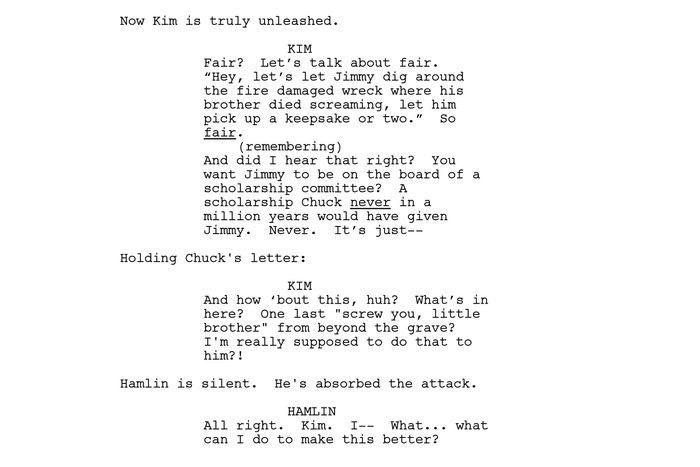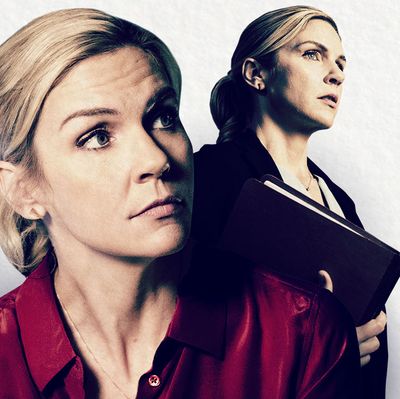
The character: Kim Wexler, reputable attorney, girlfriend of less reputable lawyer Jimmy McGill (a.k.a. Saul Goodman), woman who gets a kick out of a good con job on Better Call Saul.
The actor: Rhea Seehorn, 47, started out doing theater in D.C. and New York, then graduated from indie film to co-star in such series as I’m With Her, Whitney, and Franklin & Bash, in which she also played an attorney. Kim Wexler, her breakout role, has led to appearances in Veep and The Act.
Essential traits: Organized, Über-competent, and very good at her job; responsible but enjoys the thrill of pulling a fast one; masterful at putting on a brave face, as well as a perfectly coiled ponytail and an affordable but professional-looking suit.
The Origin
When series co-creators Vince Gilligan and Peter Gould sat down to write the Better Call Saul pilot in 2014, Kim Wexler was a mystery. Other key characters, most notably Bob Odenkirk’s Jimmy McGill and Jonathan Banks’s Mike Ehrmantraut, were already formed because they had existed on Breaking Bad. But Kim was a brand-new creation and they were not entirely sure how to build her.
“We had a vague inkling that we wanted a female character who was perhaps a love interest past tense, or potential love interest future tense,” says Gilligan, adding that it was a “distinct possibility” that the character would “fall out of importance” down the line. “It’s embarrassing to say how little we understood about the character of Kim Wexler or how important she would become.”
Rhea Seehorn landed the role in April 2014 after going through a couple rounds of auditions, callbacks, and a final screen test. She appears in two scenes in the Saul pilot, which was shot two months later — most importantly one in which Kim shares a cigarette with Jimmy in the parking garage of the Hamlin, Hamlin & McGill law firm. The scene takes place after Jimmy has lambasted one of the firm’s partners, Howard Hamlin (Patrick Fabian), during a meeting that Kim attended. Four things happen during the interaction that follows: Jimmy kicks the hell out of a trash can inside the garage elevator vestibule; he joins Kim, removes a cigarette from her mouth, takes a drag, then puts it back between her lips; they exchange seven words (Jimmy: “Couldn’t you just—?” Kim: “You know I can’t”); then Kim goes back inside the vestibule and picks up the trash can.
Seehorn read that brief, practically silent scene and saw “a treasure map of little clues” to build the foundation of Kim Wexler.
Clue No. 1: The fact that Jimmy and Kim could finish each other’s sentences and that he took the cigarette out of her mouth, puffed it, then put it right back, told her that “either they’re intimate now, or they used to be intimate.”
Clue No. 2: The fact that Kim cuts off Jimmy when he seems to be asking if she can put in a word with Howard on Jimmy’s behalf. “She immediately has boundaries about work,” Seehorn says, “and I never forgot that.”
Clue No. 3: The script stated that without looking, Kim picks up the trash can, which told Seehorn that Jimmy kicks that trash can a lot and that Kim has gotten used to cleaning up after him.
Using the script as her guide, Seehorn also locked in on Kim’s need to maintain a sense of reserve in public. “I thought, She seems extremely specific about what she says and when she says it and, very often, prefers not speaking,” she explains. “I decided that’s really a position of power. That’s not a weak person.” That discovery compelled Seehorn to carry herself physically with the same sense of purpose, and to mask Kim’s emotions to the outside world.
“I always say she would win at poker and I would lose, in a heartbeat,” she says. “She doesn’t like to be read. She will tell you when she wants you to know what she’s thinking.”
For the writers, who still weren’t entirely sure who Kim would become, Seehorn’s performance in the pilot was eye-opening. Suddenly there was Kim, or at least the basics of her character: a woman who prioritized work, who was fond of Jimmy, and who tried to place boundaries between those two things, but still felt compelled to care for him.
“It was very much going to be the Saul Goodman show, the Jimmy McGill show, and then we hired Rhea Seehorn, who allow[ed] us to do things we never saw coming,” Gilligan says. “She continued to wow us week in and week out until suddenly you say, God, what would this show be without her character?”
The First Con
The Saul writers saw Kim as a “tempering influence” for Jimmy in the early days of the show. “She’s going to inject some morality and some proper legal ethics into his basic, baseline amorality,” Gilligan recalls thinking. But Seehorn’s performance encouraged them to push the character in a more complicated direction. As carefully as Kim conducts herself professionally, season two of Better Call Saul, and the ones that follow, reveal that she shares some of Jimmy’s impulses to engage in increasingly unethical behavior.
While Kim’s pre–Better Call Saul backstory has never been fully sketched out by the creative team, certain things about her past became clear to the writers and to Seehorn as they inched her to the dark side. In season two, viewers learn that she grew up along the Kansas-Nebraska border, where she imagined a future that either involved marrying “the guy that ran the town gas station” or “cashiering down at the Hinky Dinky.” Instead, she eventually went to law school in New Mexico and got a job in the HHM mailroom so she could pay for it. “She is completely self-made,” Gilligan says, “but deep down there may be a chip on her shoulder about some of the bad times she’s had to live through.”
That chip on Kim’s shoulder made her determined to excel — when Saul begins, she’s already worked her way out of the mailroom, where she met Jimmy, and earned a law degree — but also drew her to the prospect of sticking it to the man. Those motivations collide for the first time in the season two premiere, “Switch,” when Jimmy persuades her to con a stock broker into footing the bill for an extremely expensive bottle of tequila.
“I thought, She’s clearly reluctant,” Seehorn says about reading the scene at the time. “She keeps trying to get out of it. And then, once she participates, she doesn’t just participate — she excels at it.”
That’s a lesson she’s carried into each Saul season since. Kim throws herself into situations with higher stakes, like the time she secured a plea deal for Jimmy’s security guard Huell by orchestrating a fake letter-writing campaign, or the time she pretended to be a harried mom with an incompetent partner (again, Jimmy) so she could swap out submitted blueprints for her client, Mesa Verde bank. From that first hotel-bar scam onward, Kim clearly gets a charge out of these ethically questionable if not outright illegal schemes, which helped the writers and Seehorn understand why she’s attracted to Jimmy and so committed to their relationship. They are not the same person, but their internal engines run on similar fuel.
“The inherent drama lies in the fact that she’s not making him better so much as he’s unlocking things in her that potentially make her worse,” says Gilligan.
The Accident
The most consistent presence in the life of Kim Wexler is not Jimmy McGill. It’s her ponytail. In seasons one and two, the tightly curled ponytail became her signature career look, the spring on her head that matched her tightly wound personality. Like so much about Kim, it was found through a mix of intention and happy accidents.
Hairstylist Trish Almeida worked with Seehorn, Gilligan, and Gould in the first season to find a style for Kim that, as Seehorn puts it, was feminine but also professional and no-nonsense. They decided on the ponytail for practical reasons. “Whenever women with long hair need to get shit done, you just get your hair out of your face,” Seehorn says. “We pulled it back, and my hair was longer at the time, and so it was this long straight ponytail. That felt like it could also get in the way, so Trish put a small kind of curl in it.”
As they were developing Kim’s look, Almeida gave Seehorn extensions to bulk up the ponytail and prevent it from falling, which is how the curl serendipitously fell into place.
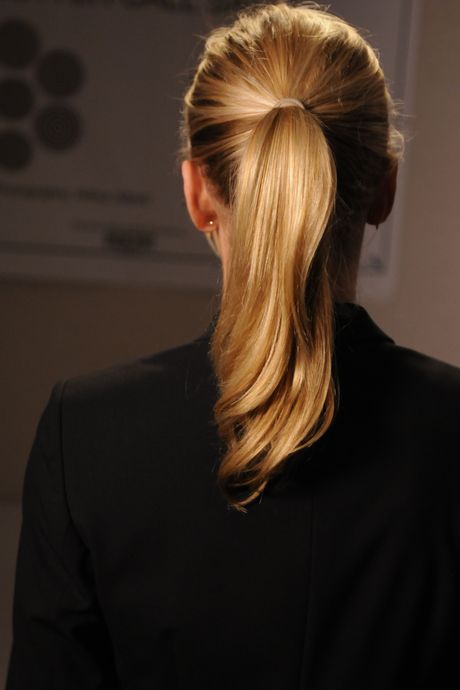
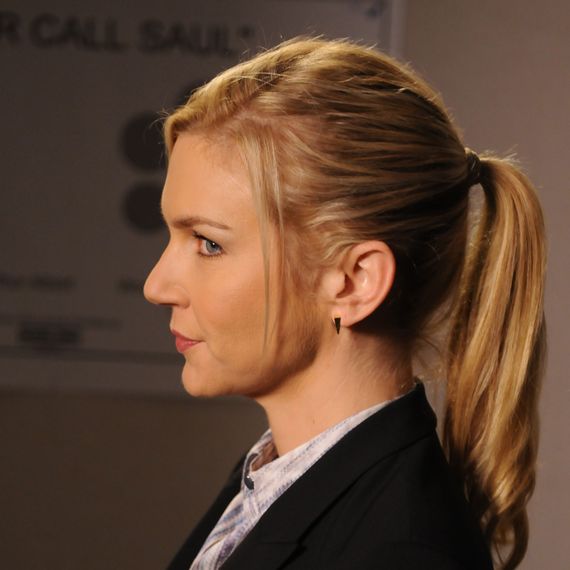
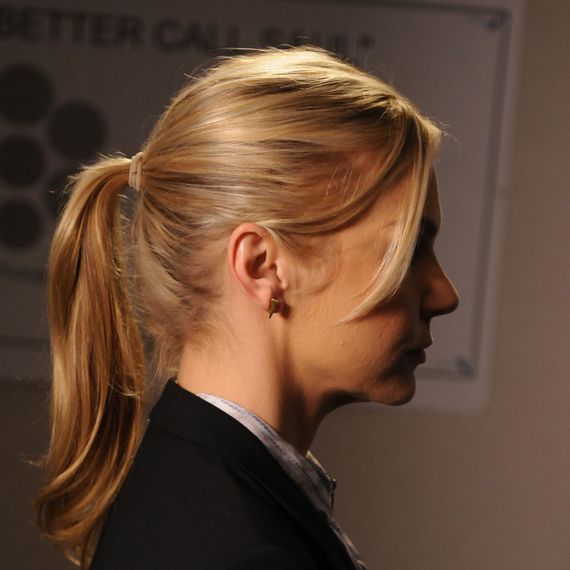
During those first two seasons, Kim’s tight ponytail signaled that she was “all business,” as Almeida puts it. She only let her hair down when she was around Jimmy and/or in the privacy of her own apartment. But at the end of season three, the Saul team began to use Kim’s hair as a barometer of her inner turmoil. After Kim got into a car accident in the season’s penultimate episode “Fall” — an accident brought on by exhaustion from working too much at HHM — she wound up with a broken arm in a sling. It would have been impossible for her to so meticulously style her hair with that handicap, so Almeida put it in a low, messier ponytail with a barette. “When it was in the barrette or when it’s like a super-sad ponytail, when it’s down, those things affect me. I feel more vulnerable as Kim when she takes her hair down,” Seehorn says. “It’s the same as even being out of a suit. I immediately feel it in my body when she’s not in the suit. It’s a bit of armor for her, her whole look.”
It was a choice that she, Seehorn, and the writers landed on for logistical purposes, but it also allowed them to subtly suggest the character was approaching her breaking point.
The Unraveling
Post-accident and post-funeral, Kim has had a much harder time keeping her feelings in check. (As Seehorn puts it, “Kim can’t continue to be on simmer and have that lid not start rumbling around.”) Her struggle becomes glaringly apparent when she blows up at Howard in the season four episode “Breathe,” after he hands Kim both a meager check for Jimmy from Chuck’s estate, and a letter Chuck had written to his brother before he died. Those gestures come after years of Howard demeaning Kim, and after he suggested to Jimmy that his brother’s death may have been a suicide rather than an accident. During the confrontation, the script states that Kim is “truly unleashed,” but offers nothing else. The writers left it up to Seehorn and director Michelle MacLaren to decide how to play her eruption.
“What does unhinged look like for somebody who has never let themselves break?” Seehorn recalls asking herself, as she and MacLaren discussed the scene prior to filming. “The fight to not fall apart, forever and always, is more interesting than completely just falling apart. In general, people try to act sober, not drunk. People try to hold themselves together in public, not fall apart.”
Seehorn thought about all the baggage Kim would bring to that conversation. Then, as they filmed the scene, she literally imagined all of those feelings manifesting in the form of a ball, and tried to swallow them while saying her lines. As the scene progressed, she wanted Kim to get really vicious with Howard. “That was a revelation for me, that Kim is not this angelic, positive person that goes around and makes sure she never does anything wrong,” says Seehorn. “She chooses who deserves good in the world and who deserves bad, and that is a very dangerous thing.”
As Better Call Saul barrels into its fifth season, Kim’s fate is the biggest unknown in the series. After being pushed to her professional and emotional limits, she and Jimmy pulled their two most brazen scams yet — saving Huell with the fake letter-writing campaign and then swapping out the Mesa Verde blueprints. She’s evolved from a repressed but upstanding lawyer into someone who’s now looking an awful lot like a near criminal. So what’s next? Will she escape Jimmy’s orbit? Or is she doomed to spiral even further?
“It’s an impending tragedy,” Gilligan says. “I get more and more uncomfortable as a fan watching this show, seeing Kim Wexler head further down this path of very, what I consider to be, self-destructive behavior. She’s doing things that are flat-out illegal. If you’re worried about Kim Wexler, your fears are only going to get compounded as you watch season five.”



